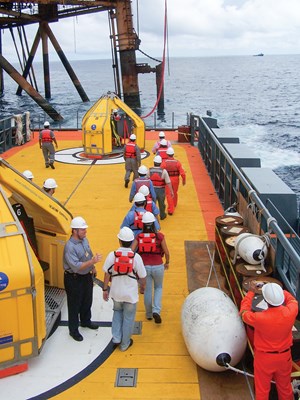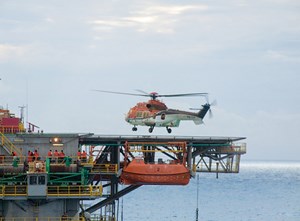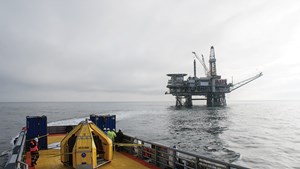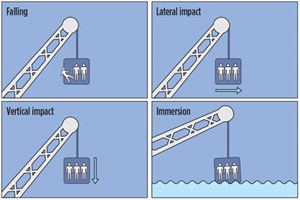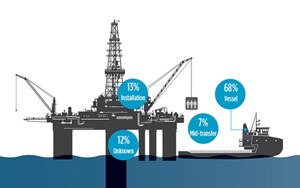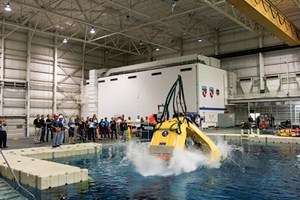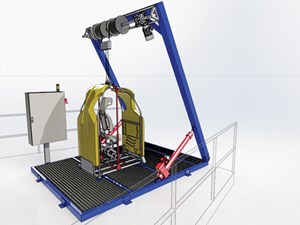New approach provides safe, efficient marine crew transfer
From the outset, the offshore oil and gas industry has used both air and marine transportation to move its workforce. Both transport alternatives carry risks, while serving the same essential purpose to transport personnel offshore in a safe, efficient manner. Historically, aviation has suffered from high numbers of fatal incidents,1 whereas injuries have been relatively low. By its nature, aviation incidents tend to have serious consequences. In contrast, marine transfer, which is performed most frequently using cranes, has suffered lower levels of fatalities,2 although injuries are commonplace.
Helicopter transfer has benefitted from a well-regulated regime, and also received considerable investment aimed at minimizing both the risk and consequence of airborne failures, Fig. 1. On the other hand, marine transfers rely on a range of assets (e.g., vessels, transfer devices and installation cranes) and organizations (vessel operators, asset operators, crane and transfer specialists), Fig. 2. As these assets were often not well-coordinated, a lack of focus and investment meant that progress in this area was slow to take root.
RISK PERSPECTIVE
Millions of transfers are performed by air and sea each year, which have, historically, been one of the greatest risk areas for offshore operations. Therefore, the safety of any transfer solution deserves to be a key consideration. Until recently, reliable public information comparing marine and aviation risk was scarce or non-existent. As a result, a majority of industry decisions on transfer solutions were, in essence, subjective. To develop a more objective criteria, DNV GL, a leading technical adviser to the oil and gas industry, carried out a study for an organization called the Marine Transfer Forum. The forum aims to bring together the most progressive asset and vessel operators, and lifting and transfer specialists, to increase industry knowledge and promote best-practice operations.
The DNV study references the latest published data for offshore helicopter operations worldwide during 2003-2007 (oil and gas production (OGP) 2009), which indicates that the average individual risk in helicopter transfer was estimated as approximately a 1:400,000 chance of fatality for each person transferred. This is considerably higher than the current risk estimate for crane transfer operations.
Helicopters are fast, relatively comfortable, and have been favored in many regions, particularly in farther offshore locations, despite inherently high costs associated with aviation services. In the current, low oil-price environment, alongside statistical evidence supporting the relative safety that marine transfer provides, the potential for significant reductions in operating costs for alternatives to helicopter transfers is attracting considerable attention.
CHANGING PERCEPTIONS
Marine transfer was once seen as the “poor cousin” of helicopter services; even vessel operators and crane suppliers regarded it as a secondary function, the primary focus being cargo-related duties and not the movement of people. By comparison, the sole purpose of deploying helicopters is to carry personnel, with an emphasis on doing it as efficiently and safely as possible.
For several decades, very basic equipment, such as swing ropes and collapsible baskets, was the main alternative to helicopter transfer. An industry culture developed around these practices, which was sometimes hard to shift, even with strong evidence that safety and efficiency could be improved readily.
Helicopter operators were encouraged to be progressive with tighter guidelines and regulations, rigorous reporting and support for technological improvement. A corresponding lack of aspiration for marine transfer was, no doubt, a major factor in explaining low levels of investment and improvement. This culture is now changing, as increasing numbers of operators recognize this as a vital logistical option and an alternative to helicopter services. Many operators now plan their marine operations with the same meticulous focus, previously applied only to aviation.
DESIGNING OUT RISK
A founding member of the Marine Transfer Forum, Reflex Marine has been at the forefront of developments in marine transfer for the past two decades. The company is involved in more than 1 million safe personnel transfers each year. Its more progressive approach to marine transfer started with a comprehensive review of crane transfer operations, supported by data sourced from operators and public resources. Analysis of these data confirmed that the key risks during crane transfers were falls, vertical impact, lateral impact and immersion, Figs. 3, 4.
Reflex Marine’s first marine transfer capsule, the FROG, was launched in 1995 and is now in regular use in diverse locations worldwide. It has a particularly strong presence in the more extreme climates. Reflex Marine’s design objectives were based around reducing the identified risks. It adopted methodologies similar to those used to evaluate the safety performance of motor vehicles and assess the risk of injury. Immersion was a lower-order risk, but still viewed as important for passenger reassurance, and the carrier was designed to float and self-right in all load conditions. Vessel motion, crane speeds, sea states and the impact on the human body were among criteria assessed. The company also developed a rigorous testing and verification program to confirm that these objectives had been met. For the past six years, about 1 million transfers per year have been performed in Reflex marine capsules without a single lost-time incident.
SPEED AND SAFETY
While improvements in transfer devices were a significant milestone in the history of marine transfer, another challenge was to provide an alternative to helicopters in terms of speed and comfort—traditionally the helicopter’s area of strength. The answer came through a collaboration with Seacor Marine Inc., which was developing the super-fast CrewZer Class vessels, combined with a nine-passenger capsule, FROG-XT, to increase the speed during high-volume crew transfers. Both companies worked to improve transfer methodologies, briefings and training. Comfort was a key consideration, and business class-style reclining seats and wifi connectivity offered an attractive alternative to flying.
This was the first time that a major vessel operator and a transfer specialist had collaborated to optimize marine transfer operations. In the first year of deployment, offshore Angola, more than 21,000 passengers were transferred, with excellent results in terms of speed, comfort and safety. Cost-savings compared to helicopters were identified at 30%. This success has since been replicated in a number of regions. Seacor also collaborated with Reflex Marine to develop transfer guidelines, 10 Golden Rules for Personnel Transfer by Crane, which makes the fundamental principles of safe transfer understandable to all.
Many offshore sites around the world can be supported conveniently by marine crew logistics, with important potential benefits. The average journey time for global helicopter flights in oil and gas is around 20 min., suggesting that marine transfer offers a viable alternative.
TRANSFER DEVELOPMENTS
The new FROG-XT range of capsules was designed to set a new benchmark for the industry, with the following key development objectives:
- Increased safety (passenger protection)
- Increased operating envelope (weather capability)
- Better ergonomics—easy entry/exit and intuitive passenger experience
- Improved ownership experience—more durable product, easier shipping, storage, inspection and maintenance.
The XT range includes four-, six- and 10-person capsules, all of which can be converted simply to Med-Evac mode, carrying a stretcher or seated casualty and accompanying paramedic. The FROG-XT range was subjected to an even more rigorous testing program than the FROG, once again referencing biomechanical studies carried out by automotive crash test experts. Key elements of the testing program:
- Vertical impact testing. Designed to simulate maximum impact speeds on the deck of a heaving vessel. An instrumented test unit allowed analysis of decelerations to verify that passengers remained within safe load limits.
- Lateral impact testing. Testing verified the performance of the unit during lateral collisions, which are relatively common during lifting operations on floating vessels. Biomechanical studies were used to indicate potential for whiplash injuries.
- Immersion and self-righting testing. Full immersion and self-righting tests were performed in a range of the most extreme passenger loading configurations. This included a free-fall test from 7 m. The capsules are hydro-dynamically designed to enable safe entry into water at high velocities, for example in free-fall scenarios.
Testing was conducted at the company’s development facility in Barcelona, Spain. Some of the tests were repeated in demonstrations at the NASA Neutral Buoyancy Laboratory in Houston, Fig. 5. FROG-XTs are now operating in more than 28 countries for applications including routine crew changes, high-volume transfers and operational contingency transfers. Feedback from the industry has been extremely positive.
New standing transfer carrier. Reflex Marine has recognized a preference in some regions for transfers in the standing position, with limited restraints (harnesses). To improve safety in these regions, the company is now developing a four-passenger standing carrier. The carrier will have a very small footprint (67 in. × 67 in.), and is also designed for an improved ownership experience (e.g., durability, shipping, storage, inspection and maintenance). It will be the only standing transfer device that has been subjected to rigorous verification and testing, which will include impact testing (to demonstrate the safe operating envelope) and full immersion and self-righting tests. Although less weather-capable than the FROG-XT range, it will have a design limit of at least 1.5 m significant wave height.
Case histories. Stena Drilling used the FROG-3 carrier for many years on its Stena Carron drillship and the Stena Don semisubmersible for projects in Europe, Canada and Africa. Stena upgraded recently from FROG-3 to FROG-XT4 for use on the Stena Carron, a deepwater, harsh-weather drillship. The vessel is currently offshore northwestern Africa, and the FROG-XT4 is the preferred method for weekly crew changes. Stena found that pre-use inspections were easier to perform, due to improvements to the rigging arrangements. Its barge master commented, “The FROG-XT4 feels robust, and passengers feel protected when being transferred in the device.”
Elsewhere, the unit acts as a contingency method for another system. Royal Wagenborg purchased a FROG-XT4 for use on the offshore maintenance support vessel, the Kroonborg. The Kroonborg is equipped with a motion-compensated, offshore access system (walk to work), its main method for transferring personnel. The vessel also has a motion-compensated crane and a FROG-XT4 as contingency. The FROG-XT4 offers a wider operational window for personnel transfers, so it can be used when operating conditions are unsuitable for gangway access. If maintenance is required on the walk-to-work system, the FROG-XT will be used and is also kept on standby for Med-Evac transfers. This combination of a walk-to-work system and a FROG-XT provides the operator with a flexible personnel transfer system that has removed the need for helicopter transfers.
Accessing normally uninhabited installations. The increased use of normally unmanned installations (NUIs) across the energy industry requires access providers to adapt to new demands. In response, Reflex Marine is developing a new, remotely operated, winched-access concept, Fig. 6. Current methods to access NUIs include:
- Ladder access. This method utilizes thrust and friction when a large bow fender is thrust against a ladder structure. Passengers then step-over, in what is colloquially termed the “bump and jump” method.
- Swing rope transfers. A vessel is maneuvered close to a landing platform, and passengers simply swing across the gap on a rope.
The core of the system is a FROG-XT1 single-passenger capsule, although it is also suitable for higher-capacity capsules. Winch-based access is very flexible and adaptable to most offshore support vessels. The system can work with a new, remote-controlled crane on the installation, or alternatively, a bespoke remote-controlled hoisting davit can be spotted on the installation. This approach is similar to that used for launch and recovery of diving bells and ROVs.
RANGE OF ACCESS OPTIONS
Recent developments in “walk-to-work” systems involve retractable motion-compensated gangways to connect a vessel and installation. The more advanced systems have proved to be reliable and weather-capable. However, associated vessel and equipment costs are high, so applications have focused on high-volume transfer operations. The increasing range of options open to operators makes it possible to plan higher levels of system redundancy and reduce the risk of extended downtime.
For example, marine transfers can be used in situations when helicopters cannot, e.g., weather conditions such as fog or during disruption to aviation. Crane transfer provides contingencies for gangway or walk-to-work systems and can be used with a wide range of vessels for ad-hoc transfers and occasional inter-field crew movements. This flexible, integrated approach provides greater resilience and increased capability for emergency response.
EMERGENCY RESPONSE
A flexible, integrated approach is particularly important when considering emergency responses. On-site managers have a limited range of tools at their disposal for major evacuations and may call for a range of responses at different phases of an emergency. It is, therefore, essential that options that do exist are well understood by supervisors and crews and, as always, planning and preparation are crucial. In general terms, evacuation options divide into dry and wet methods; the latter being generally less desirable (and higher-risk) as they involve personnel entering the sea.
Crane transfer is used frequently for emergency operations, including life-saving medical transfers and emergency evacuations. Like helicopters, its primary role is logistical. In emergencies, it may be needed for more onerous duties. Emergencies come in many guises. Scenarios include hydrocarbon releases, fires, stability issues and external marine hazards (drifting vessels), to name a few. Harsh weather can compound the challenge. Some threats increase steadily with time, others escalate rapidly. Timely and well-executed responses can prevent a minor incident escalating into a major incident.
Crane transfer offers a flexible response that is immediately available and under the full control of on-site management. Potentially, up to 100 personnel could be evacuated prior to arrival of the first helicopter. Crane transfer played a vital role in response to the incident with the P-36 floating production vessel, which sank in Brazil in 2001, where 138 crew were rescued, using crane transfer, and 24 remaining crew were rescued by helicopter.
All evacuation methods have limitations and should be viewed as complementary rather than competing. A specific situation will dictate the most appropriate method of evacuation. Hence, it is important to take an integrated approach to emergency planning.
A LOOK TO THE FUTURE
The past two decades have seen major improvements in marine crew logistics. New transfer solutions and enhanced vessels (e.g., CrewZer class) have played a vital role in this shift. These advances have been supported by operators taking a more strategic approach to their crew supply operations. A focus should remain on designing out risk, increasing risk awareness and disseminating best practices. There are now viable alternatives to helicopters, and increasing numbers of operators are switching to marine-based crew logistics. Operators can look to marine crew supply with confidence, as when carefully planned, it offers safety, comfort and efficiency. ![]()
REFERENCES
- “Safety performance of helicopter operations in the oil & gas industry – 2007 data,” OGP, August 2009.
- Risks of marine transfer of personnel, DNV GL and Reflex Marine, June 2014.
- Advancing offshore decarbonization through electrification of FPSOs (March 2024)
- Subsea technology- Corrosion monitoring: From failure to success (February 2024)
- Driving MPD adoption with performance-enhancing technologies (January 2024)
- Digital transformation: A breakthrough year for digitalization in the offshore sector (January 2024)
- Offshore technology: Platform design: Is the next generation of offshore platforms changing offshore energy? (December 2023)
- 2024: A policy crossroads for American offshore energy (December 2023)
- Applying ultra-deep LWD resistivity technology successfully in a SAGD operation (May 2019)
- Adoption of wireless intelligent completions advances (May 2019)
- Majors double down as takeaway crunch eases (April 2019)
- What’s new in well logging and formation evaluation (April 2019)
- Qualification of a 20,000-psi subsea BOP: A collaborative approach (February 2019)
- ConocoPhillips’ Greg Leveille sees rapid trajectory of technical advancement continuing (February 2019)

